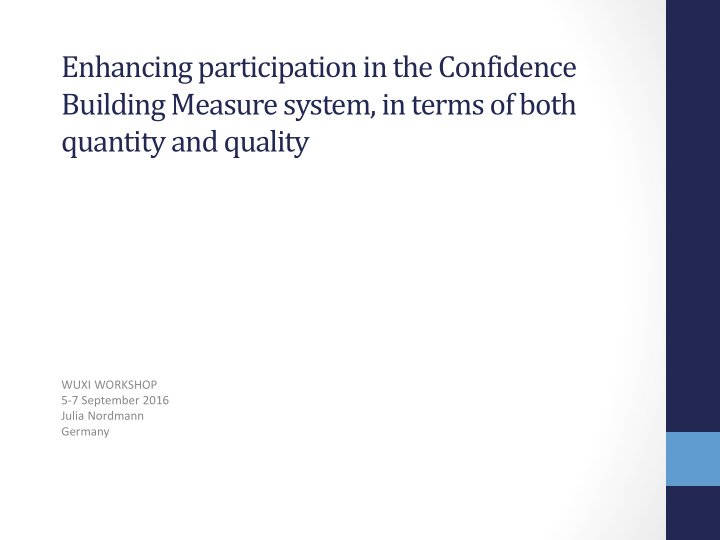



Enhancing participation in the Confidence Building Measure system, in terms of both quantity and quality WUXI WORKSHOP 5-7 September 2016 Julia Nordmann Germany
CBMs… CBMs were agreed upon in 1986 promote transparency increase confidence in compliance Goal is to demonstrate political commitment in the absence of a verification protocol provide a useful review of the status of national implementation bottom line: we depend on this alternative way of demonstrating compliance.
Advantages of CBMs • CBMs are a familiar aspect of the BWC, having existed for over twenty years; • most information requested on CBM forms is still relevant in the BWC context; • CBMs are state-led, adaptable and promote openness; • CBMs are synergistic; • provide a bridge between diverse reporting structures at the national, international and civil society level, and, finally, • CBMs can be improved at a low cost with positive impacts.
Disadvantages of CBMs • CBMs were intended to be an interim solution, not a permanent fixture of the BWC; • the CBM mechanism maintains an ambiguous relationship between Article V, on compliance, and Article X, on cooperation; • CBMs are a bolted on “extra,” having not been integrated into accountability, compliance or implementation frameworks, and, • finally, CBMs provide partial transparency between states and are opaque to the outside world.
Challenges • submission rate is low • value of information • no follow-up / analysis of CBMs provided Key question: how can we make more effective use of CBMs?
Positive indicators for change • an interest on behalf of States Parties in CBMs and their further development; • contributions made by civil society in preparation for the RevCons • room for creativity and scope for improvement.
Key Question • How can we make better use of this tool and improve quality and quantity of CBMs? • Quality: • Is the information relevant? Is it useful? • Quantity: • What are obstacles in the CBM submission process? How can we overcome them?
Position of the EU relating to the Eighth Review Conference of the EU WEOG BWC BWC/CONF.VIII/PC/WP.5 Strengthening the ability to take action: an essential agenda for USA WEOG the Eighth RevCon BWC/CONF.VIII/PC/WP.9 Strengthening the ability to take action: A realistic agenda for the USA WEOG Eighth Review Conference BWC/MSP/2015/WP.3 Strengthening confidence-building and consultative mechanisms USA WEOG under the BWC BWC/CONF.VIII/PC/WP.6 USA WEOG Strengthening confidence building and consultative mechanisms under the Biological Weapons Convention BWC/CONF.VIII/PC/WP.6/Rev.1 Strengthening confidence-building measures in regard to dual use DEU WEOG materials BWC/CONF.VIII/PC/WP.35 AUS CAN CHL COL CRI ECU GHA JPN GS MYS NOR PHL KOR CHE THA Working Paper on providing reassurance on Biological Weapons Convention (BWC) implementation BWC/CONF.VIII/PC/WP.34 AUS CAN JPN MYS KOR GS CHE Step-by-step approach in CBM participation (2016) BWC/CONF.VIII/PC/WP.36
CBM Quantity • both ISU and States Parties have offered assistance related to the CBM process • Guide to Participating in the CBMs (UNODA 2015) • submission rate remains below the states parties political commitments and therefore our expectations. • open dialogue in order to find out how implementation of this provision of the Convention could be enhanced . • CBM submission requires effort and coordination among internal ministries and agencies • efforts of all member states are required.
Sources of advice and assistance • Biological Weapons Convention Implementation Support Unit, Geneva • WMD Strategy and Council Decisions in support of BWC and biosafety and biosecurity, Brussels • CBRN risks and threats mitigation, Brussels • Instrument for Stability, Nuclear Safety, Brussels
Proposals to improve quantity • increase ISU support (WP.5 by the EU) • CBM guide (WP.5) • step by step submission (WP.36) • CBM assistance network coordinated by ISU (WP.6) • training, translation, workshops and electronic submission(WP.6) • formalize ISU role (receiving CBMs) (WP.21)
CBM Quality • Does the information provided correspond to relevant S&T developments? • Is it useful? • Dual use capabilities of hazardous biological materials = key items of discussion in BTWC context • CBMs however do not yet include information on the export control of genetically modified organisms (German proposal: amend Form E of CBMs to include this.)
Proposals to improve quality • examine and analyze submissions • expand functionality of electronic platform to enable analysis • revise Form A and Form E (WP.6): military and civilian, implementation measures • informal procedures to clarify information (WP.6)
German Proposal • Amend Form E to include information on the export control of genetically modified organism and specific genetic elements linked to export controlled microorganisms and toxins • Why? • Genetically modified organism and synthesized genetic sequences were not on the screen when drafting form E. • Today: major dual use risk.
Outlook • CBMs have a huge potential that is not yet fully explored. • Eighth RevCon = opportunity to improve the CBM system in order to provide better data, of more member states, to the use of States Parties • Germany is looking forward to an inclusive and dynamic dialogue on this subject. • Thank you for your attention.
Recommend
More recommend